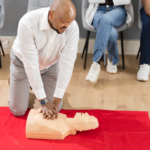What is SIDS?
SIDS is the sudden, unexplained death of a baby under one year of age. While the exact cause of SIDS is unknown, it is believed to be related to an underlying health condition or breathing problem.
There are several factors that can increase the risk of SIDS, including:
- Sleeping on the stomach or side
- Overheating
- Exposure to smoke
- Premature birth or low birth weight
- Family history of SIDS
- Lack of prenatal care
- How can CPR help in an emergency?
Babies are at a higher risk of SIDS if they have their heads covered, and unnecessary items such as soft toys, cot bumpers and pillows can increase the risk of head covering or lead to an accident.
- An empty cot is a safe cot.
- Baby should always be placed to sleep on their back.
- Baby’s sleep space should be breathable and not fully enclosed as this can lead to suffocation – take cot bumpers, pillows and decorative items out when placing baby to sleep.
In the event of an emergency, CPR can be a life-saving technique. CPR, or cardiopulmonary resuscitation, involves performing chest compressions and rescue breathing to help maintain blood flow and oxygen to the brain and other vital organs. For a baby, the technique is slightly different than for adults, so it’s important to learn proper infant CPR techniques.
Learning CPR can give you the knowledge and confidence to respond in an emergency situation. By performing CPR, you can help stabilize your baby until medical professionals arrive.
How can you reduce the risk of SIDS?
While there is no guaranteed way to prevent SIDS, there are several steps you can take to reduce the risk. Some of these steps include:
- Always placing your baby on their back to sleep
- Using a firm, flat sleep surface without any soft objects or loose bedding
- Keeping your baby’s sleeping area in the same room as you for the first six months of life
- Avoiding exposure to smoke
- Breastfeeding your baby, if possible
- Using a pacifier during sleep
- Providing tummy time during awake hours
- In addition to these steps, learning CPR can be a valuable tool in reducing the risk of SIDS. By being prepared for an emergency, you can respond quickly and confidently in a crisis.
In conclusion, SIDS is a devastating tragedy that no parent wants to imagine. But by taking steps to reduce the risk of SIDS and learning CPR, you can be better prepared for an emergency situation. Don’t wait until it’s too late – learn CPR today and take steps to keep your baby safe.

Adult CPR & First Aid Course
Adult CPR & First Aid Course Our CPR and First Aid Course will provide you with Adult CPR and standard first aid information to meet all the requirements for certification. You will learn the appropriate skills and techniques to handle a variety of situations, from unresponsive victims to serious wounds.

CPR for Professionals Course
The Resuscitation Council CPR for Professionals Course is designed for medical professionals (physiotherapists, chiropractors, homeopaths, doctors, nurses, dentists, pharmacists etc), who are registered with the Health Professions Council of South Africa. Members of the public are also allowed to attend this course. Medical professionals who need to learn or stay

Basic Life Support Course
Basic Life Support Course This American Heart Association Course is designed for medical professionals (physiotherapists, chiropractors, homeopaths, doctors, nurses, dentists, pharmacists etc), who are registered with the Health Professions Council of South Africa. Members of the public are also allowed to attend this course. UPCOMING COURSE DATES advanced life support
Burns: do you know the different types & how to treat them?
With National Burn Awareness Week (6-12 May) still top of mind, as well as the knowledge that as we approach winter our children will be increasingly exposed to heating appliances and fires, we asked Sr. Catherine Rodwell from Survival CPR to break down the different types of burns and explain

Caregiver Refresher Course
Caregiver Refresher Course Our Survival® Caregiver Refresher Course is specifically designed to enhance and update the skills of qualified Caregivers already working within the Caregiving field. This course is not a replacement for our full Survival® Caregiver Course but aims to build upon a Caregiver’s existing knowledge and to ensure





